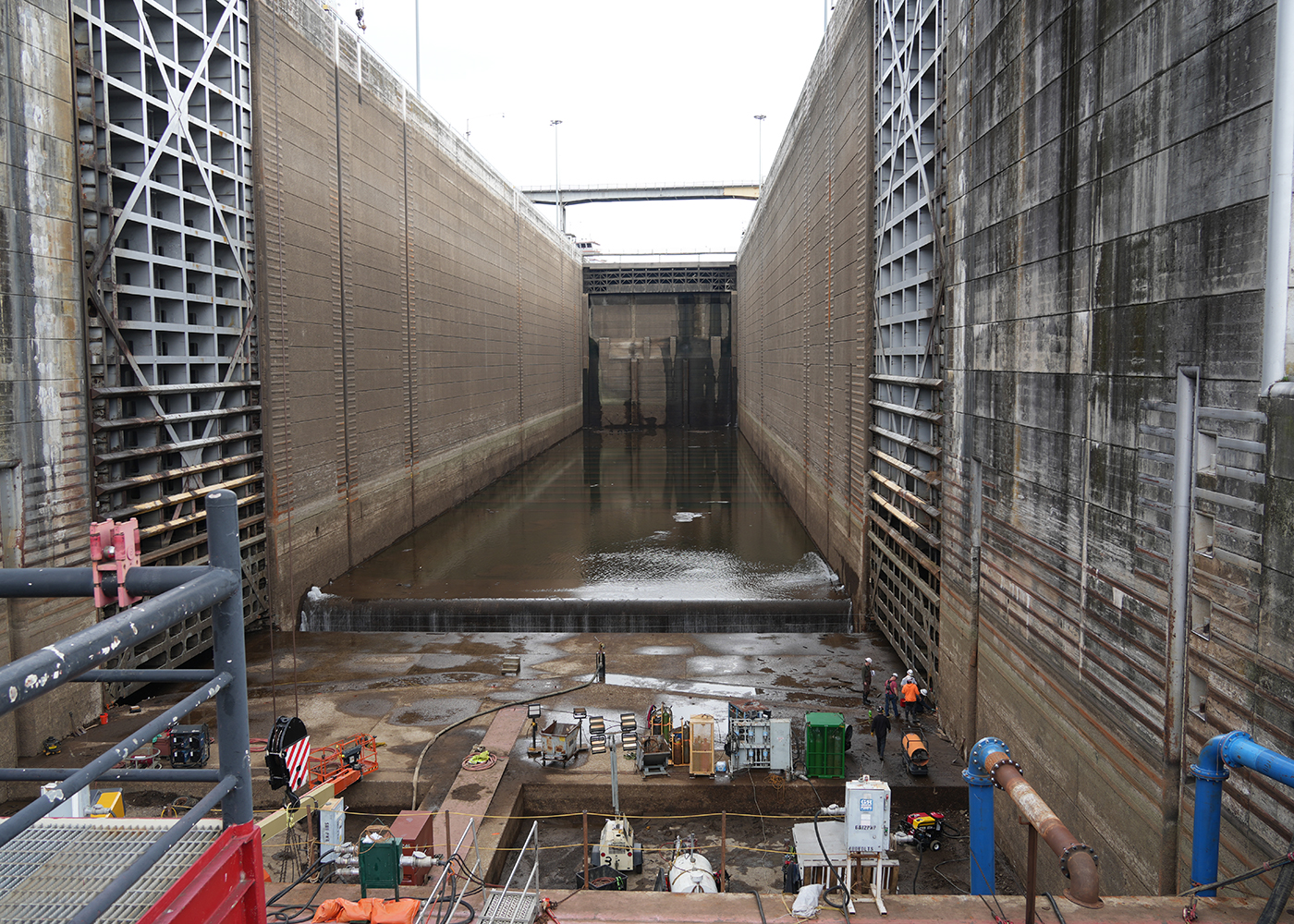Dewatering of the main lock chamber at Wilson Lock and Dam found more extensive cracking than previously known, and inspectors are assessing what that meant in terms of repairs.
“Some cracks had propagated farther than they could see,” Megan Simpson, maintenance section chief for the Nashville Engineer District, said of the inspectors’ initial look at the dewatered chamber compared to what divers and a remotely operated vehicle previously determined.
The Ohio River Division’s Heavy Capacity Fleet was about a day and a half behind in the planned dewatering and inspection of the chamber, Brian Mangrum, chief of the Nashville District’s technical support branch, said in a weekly videoconference call with industry on November 26.
While recent repairs made to caisson slots to allow the dewatering were holding, some adjustments were needed, Mangrum said. There also had been some issues with pump operability that contributed to the schedule delay, he said.
The chamber had been scheduled to be dewatered November 19-21, but dewatering was completed at 11 a.m. November 23. That, in turn, pushed a meeting between the Corps and the Tennesse Valley Authority to discuss results of an inspection to November 27. TVA owns the locks and dams along the Tennessee River, while the Corps of Engineers operates and maintains the navigational locks.
Simpson said nondestructive testing of welds began November 26. The Corps expected to be able to provide more information once all testing is complete.
The lock’s main chamber, located at Tennessee River Mile 259.4 in Florence, Ala., was closed to navigation September 25 after operators heard popping noises when emptying and filling it. Simpson said, while emptying the chamber for the recent dewatering, crews heard the noises and also felt vibration but had not determined the exact cause.
So far, dewatering has shown not only typical gate cracking but also the cracking in the pintle casting that divers and an ROV previously identified, Simpson said. The cracking at the pintle casting was not present in a 2022 inspection, she said.
A risk assessment decision on whether the chamber’s lower gates can be operated between two planned dewaterings was still expected December 1, Mangrum said, despite the delays.
Simpson said the gates had been moved slightly to allow for inspection, but the concern about their safe operation had more to do with pressure against the lower miter gates when the chamber fills and empties than the gates swinging open and closed on the pintle ball, which acts as a hinge or pivot point. The pintle casting covers the pintle ball.
Navigation traffic is moving through a two-step, 60-by-300-foot auxiliary chamber that can hold one typically sized barge a time. This has led to extensive delays for tows transiting the lock. The Corps’ online lock queue report on the afternoon of November 26 reflected an average delay of 16,749 minutes over the past 24 hours, or just over 11.6 days.
Repair plans developed before the dewatering called for the regional Heavy Capacity Fleet to complete weld repairs during an initial dewatering through December 20.
A second dewatering, during which each gate leaf must be jacked up to access pintle components and bushings to replace them is scheduled for January 20 to April 20, during which time additional stabilization and contact block adjustments would be completed along with operational testing prior to returning the lock to service.
The Corps has said operation of the chamber between the dewaterings is dependent on what a full inspection reveals. It is possible that only traffic that is too large to transit the auxiliary chamber–including United Launch Alliance ships that carry rocket stages for the space program–may be given permission to transit the main chamber. Another possibility is that more traditional tows may be able to use it as well.
Nikki Berger, TVA’s navigation program supervisor, said November 26 that materials to forge the new pintle components were expected to be shipped over the next week, with their receipt expected by December 12. Traditional casting of those components would have taken about a year, so the TVA Power Services Shop is instead forging them, a process expected to take 12 to 16 weeks.
————
Featured photo caption: Crews inspect Wilson Lock and Dam, Tennessee River Mile 259.4 in Florence, Ala., on November 25 following its dewatering for miter gate repairs. The main lock chamber has been closed since September 25 after operators heard popping noises that turned out to be cracking of the gates and pintle components. (Photo by Michael Davis/Nashville Engineer District)



